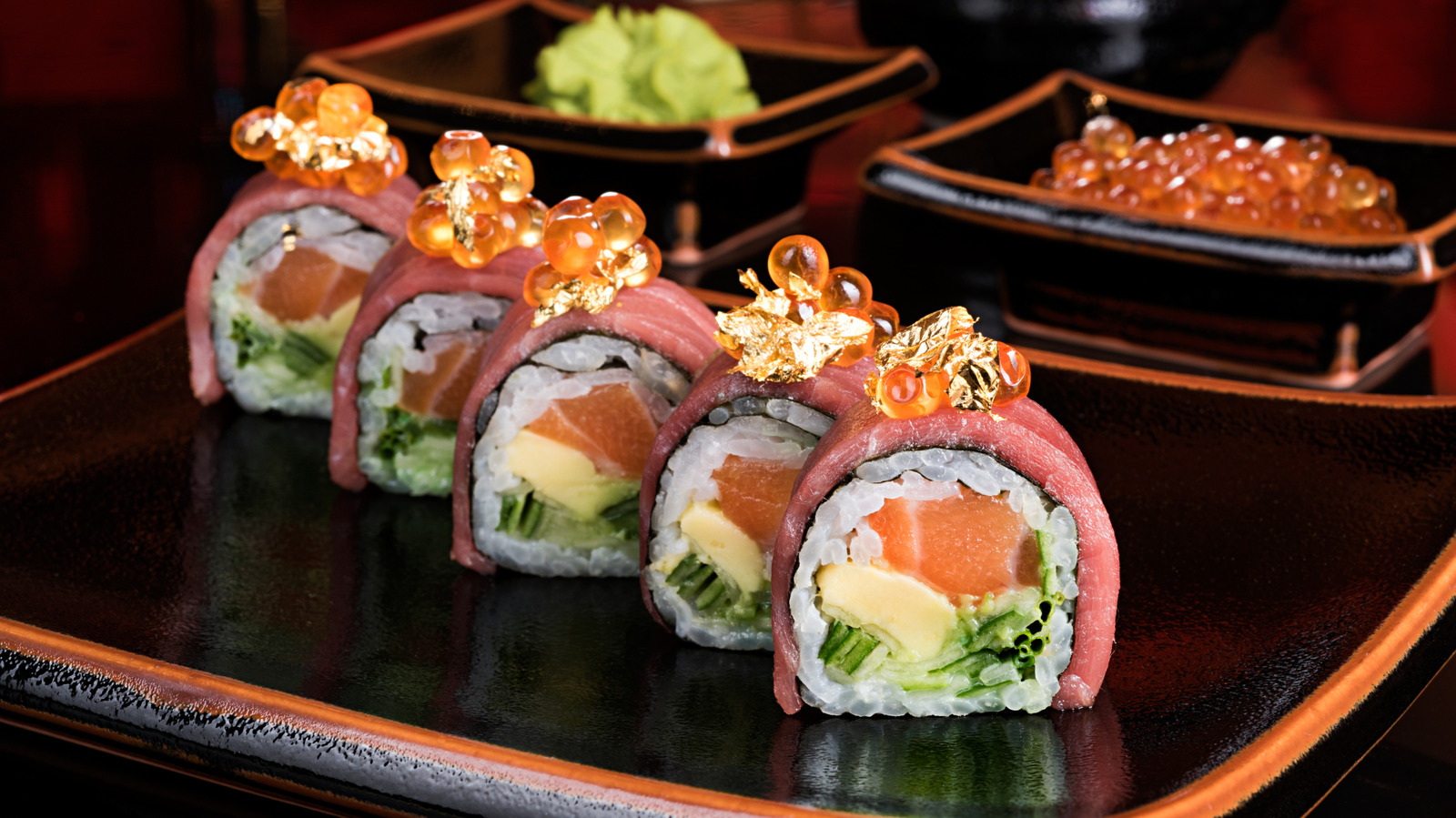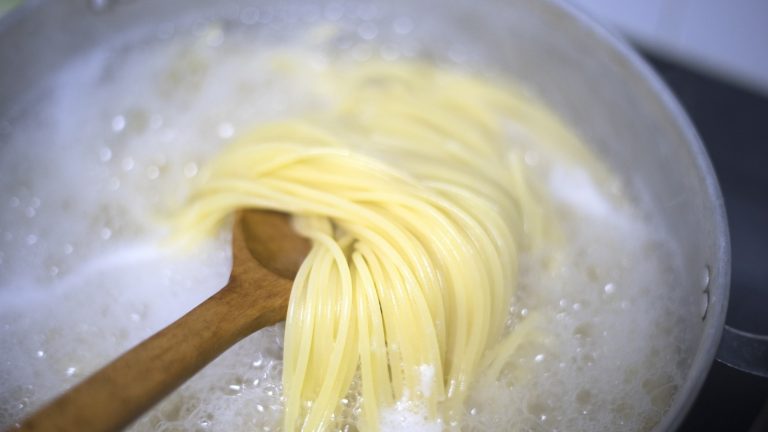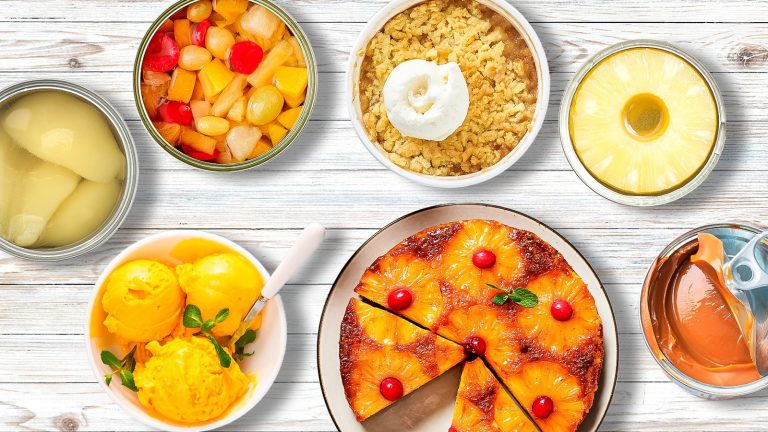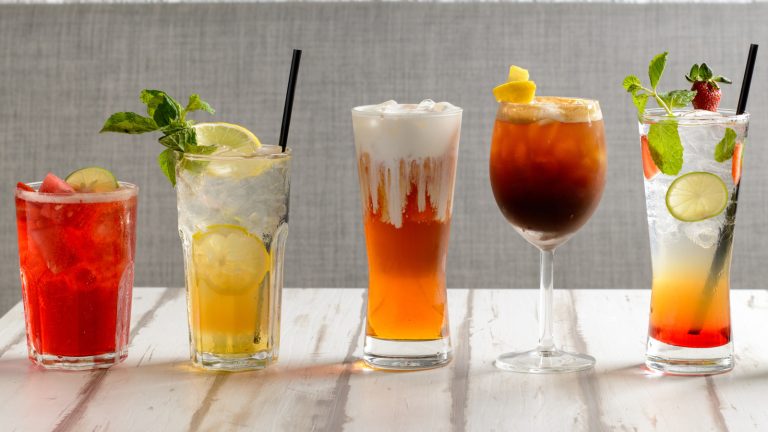Sure, sushi can be enjoyed even if you have no idea what you’re eating. For starters, you’ll always find these fish species on any sushi restaurant menu. And if you’re new to the cuisine, get familiar with these classic maki sushi rolls, ranked worst to best. Still, it’s a lot better if you know your way around. From chopstick etiquette to over-ordering, there are a few tips and tricks you can learn to maximize your enjoyment next time you visit a sushi restaurant.
We spoke with four experts in the sushi space to get more of an understanding of what common mistakes they see among novices at sushi restaurants. These experts are chef Kenji Koyama of Kenbey Sushi in the Silverlake neighborhood of Los Angeles, chef de cuisine Joel Hammond of Uchi West Hollywood, chef Nikki Zheng from Sushi Akira in New York City, and Brian Rosman, owner of Dog and a Duck, a public relations, social media, and influencer marketing agency. Here are the 13 mistakes they see most often at a sushi restaurant.
Thinking sushi is a snack
We all know somebody who says sushi never fills them up. That person most likely isn’t ordering sushi correctly. “Come hungry,” Brian Rosman advises. “We have a wide variety of fish and flavors to explore. It would be a shame to miss out because you filled up before you arrived.” He adds that it’s also good manners to let the chef know if you’re getting full. This is even more important at an omakase restaurant, where the chef curates the meal for you.
Bringing your appetite to any sushi restaurant is a crucial first step to a positive experience. Of course, two pieces of nigiri don’t constitute a whole meal, but combining a few small plates and rolls listed throughout the menu can satiate anybody’s hunger. One advantage is that you’ll get to try more decadent dishes. Plus, not eating much at a sushi restaurant can be a mistake of its own.
Traditionally, leaving food uneaten can be viewed as rude in Asian cultures. In America, though, there’s a little more leniency. “It’s not ‘rude’ in a Western sense,” chef Nikki Zheng from Sushi Akira says, “but in Japanese culture, leaving food can be seen as wasteful. We encourage guests to pace themselves and ask questions. We’re happy to guide portioning.”
Ordering too many dishes
With the idea of not being wasteful at the front of mind, you’ll want to avoid having eyes larger than your stomach at a sushi establishment. Unlike many restaurants that prefer to serve everything at once, sushi restaurants typically have no problem with coursing out your meal into smaller portions.
“Start small and order more as you go if needed,” Brian Rosman says. “There’s great respect for the fish and the craftsmanship behind each piece.” So how many rolls should you order? Chef Nikki Zheng tells us, “Eight to 10 pieces of nigiri or two to three rolls per person is usually satisfying without being excessive.”
If you’re getting close to the end of your meal and are still hungry, don’t be afraid to ask for more. “Start small with a couple of dishes and see how much room you have,” chef de cuisine Joel Hammond says. And if you do happen to have some leftover sushi that you can’t finish? “Just make sure to bring it home with you and make yourself a nice bento for later!” he says.
Not speaking to the chef and servers
A good sushi restaurant is supposed to provide an intimate experience, but not communicating with your chef and servers can deter that. If you have questions or concerns, kindly let the restaurant staff know. Even if you don’t have any specific questions, it never hurts to build a rapport with the people making your food.
Brian Rosman offers some suggestions for the beginning of the meal. “Greet and thank the chef, let the chef know your dislikes ahead of time, and trust the chef’s recommendations,” he says. “At the end of the meal, thank the chef and share which dish was your favorite.”
While service is a little different at omakase restaurants, manners matter just the same. “A great omakase experience is not just about the technique; it’s also about the hospitality,” chef Nikki Zheng says. But that goes both ways. “Always show appreciation to the chef,” she says, “even a small bow or ‘thank you’ is deeply valued.”
Ordering Americanized sushi
It’s easy to fall into the habit of ordering what you are already comfortable with. Sushi, though, is about the joy of many flavors — the delicate difference among the types of fish mixed with warm rice and other ingredients. Go beyond your comfort zone of the California roll or shrimp tempura that are popular in Western cultures, and you may find something you love.
Oftentimes the simplest rolls on the menu are the most authentic to Japanese cuisine. “In Japan, portions are smaller to emphasize quality,” Brian Rosman says. “In the U.S., pieces tend to be larger to reflect perceived value.” Instead of a large $12 roll with all the bells and whistles, try two different $6 rolls with just the good stuff.
“Simple rolls like tekka maki (tuna roll) or kappa maki (cucumber) are more traditional,” chef Nikki Zheng explains. “Rolls with cream cheese, spicy mayo, or deep-fried ingredients tend to be Western inventions — not wrong, just not classic Japanese sushi.” Chef Joel Hammond agrees, saying that the “most authentic would be tekka maki,” while the “least authentic would be tempura fried or anything slathered and torched with a ton of spicy mayo and eel sauce.”
Making substitutions
What you see is what you get at many sushi restaurants around the world. Substitutions can be hard because taking the cucumber out of your rainbow roll isn’t as easy as it sounds. If you have any food allergies, though, make sure to communicate that to the staff before ordering or eating anything.
“Sometimes guests try to customize every piece in an omakase, but omakase means ‘I leave it to you,'” chef Nikki Zheng says. “Trusting the chef is part of the experience. We always accommodate allergies and restrictions, but letting go of control can result in a much more memorable and meaningful experience.” Try your next sushi roll as-is, and leave a little trust for your chef.
This rule of thumb goes for most sushi restaurants — even the most expensive of them. “If you are sitting at a high-end omakase,” advises chef Joel Hammond, “please enjoy the sushi and sake as the restaurant recommends.”
Soaking the sushi in sauce
This mistake is one that many of us are guilty of making. “Don’t use too much soy sauce,” chef Kenji Koyama advises. The salty, umami flavor in soy sauce is supposed to complement the fish in your sushi, not drown it out.
Remember that sushi is about the balance of flavors. And you don’t want that balance to get lost in the sauce. “If you immediately pour soy sauce and put wasabi on your sushi, it is typically considered insulting to the chef,“ Joel Hammond says. Brian Rosman agrees, adding, “a light touch of soy goes a long way.”
Beyond the amount used, there is also a proper way to dip your sushi in soy sauce. “You don’t want to soak the rice in the soy sauce, which can be way too salty or overpower the fish’s flavor,” chef Nikki Zheng of Sushi Akira explains. You also risk the rice falling apart this way and making a mess of your roll.
Not knowing what to do with wasabi
When you start using soy sauce sparingly, you will also want to follow suit with wasabi, which is different from horseradish. In fact, you may want to withhold the spicy green paste altogether. “In omakase restaurants, wasabi and soy sauce are already placed by the chef with a perfect amount based on the texture and flavor of the fish,” chef Nikki Zheng says. “If it’s a fattier fish, the chef normally will put a little more, compared to a white fish.”
Brian Rosman says that’s a good rule to follow based on the fish type. He also agrees with Zheng, saying, “At many sushi bars, especially if you’re having omakase, the chef seasons each piece for you — so you may not need to add anything.”
Taste your sushi without any wasabi or soy sauce, and add some to suit your preference only after the first big bite. “If you need soy and wasabi for the flavor, use a very small amount and refill when needed,” chef Joel Hammond says.
Using ginger as a topper
Each of our experts gave the same advice when it comes to the pickled ginger — or gari — that comes on the side of nearly every sushi roll. As put simply by chef Nikki Zheng: “Ginger is a palate cleanser, not a topping.”
“Never place pickled ginger on top of your sushi,” Brian Rosman explains. “Gari is meant to cleanse your palate between bites, not be eaten with the sushi.” These paper-thin slivers of ginger are meant for consumption on their own before your first bite of sushi as well as in between bites of different rolls in order to get your taste buds ready for the next piece of fish and fresh ingredients.
“Eating [gari] in between dishes is okay,” chef Joel Hammond reiterates. But how much ginger should you be consuming between dishes? Typically, one large slice between bites of different rolls should be enough to not go overboard. “The amount of ginger given at the beginning,” says chef Kenji Koyama, should be enough to last a standard sized meal. If you do run out early, though, the chef certainly will not be insulted if you ask for more.
Committing a chopsticks faux pas
You won’t be kicked out of a sushi restaurant for forgetting your chopsticks table manners, but there are important traditions to keep in mind as many have been passed down over centuries and migrated overseas from Japan.
“One of the most common things I see is guests rubbing their chopsticks together to remove splinters,” Brian Rosman says. “It’s considered rude, as it implies the chopsticks are low quality.” Chef Nikki Zheng agrees, saying, “Sticking chopsticks upright in rice or rubbing them together — both are considered disrespectful in Japanese culture.”
Like in Western culture, food is a big part of funerals in Japan. Though traditions differ, the sentiment of coming together through food remains the same. Sticking chopsticks vertically in a bowl of rice is an easy mistake to make, but it resembles a common funeral ritual in Japan and should always be avoided. Passing food between people from one pair of chopsticks to another also mimics a funeral ritual and should be avoided as well.
Another faux pas is “leaving your chopsticks in your bowl of food,” according to chef Joel Hammond. “Always lay them across the top of the dish, or place them on their chopstick rest when you are finished.” Chef Kenji Koyama takes it one step further, advising diners to “always use chopstick rests.” Another tip? Avoid pointing your chopsticks at people or using them to move plates.
Making other unknowingly rude gestures
Table manners at a sushi restaurant go beyond just the chopsticks, though there’s nothing here that you probably haven’t heard elsewhere. “Simple things go a long way,” chef Nikki Zheng says, pointing out that diners should not pour their own sake first. Instead, they should serve others before themselves as a sign of respect.
Also worth noting? “We’ve noticed that many guests are often on their phones, even when the chef is serving them or presenting the sushi,” she says. “While we understand people may be multitasking, acknowledging the chef — even with a quick glance or nod — is a meaningful gesture of respect in omakase culture.” Taking a photo is fine — Brian Rosman suggests asking for permission first — but recording your entire experience and watching the sushi presentation through the camera on your phone screen is not the appropriate way to enjoy omakase. “Keep your voice at a respectful volume,” Rosman says, “and avoid being on your phone unless you’re taking a photo.”
None of these rules are anything groundbreaking when it comes to dining out. As simply put by Joel Hammond: “Do not be rude to the team creating your experience. If your experience falls short of your expectations, be honest.”
Taking tiny bites
Try to eat a whole piece of sushi in one bite. “Each slice of maki or each nigiri is one bite,” says chef Joel Hammond. “For me, half-eaten food on a plate implies you did not like it.” Other chefs may feel similarly. “If someone bites something and puts it back,” says Brian Rosman, “it’s often because the piece was too big or they didn’t like the taste.”
Larger specialty rolls may be too much to eat with one bite, but most traditional sushi should be no issue. “At an omakase counter, each piece of sushi is carefully crafted to be enjoyed in a single bite,” chef Nikki Zheng says. “This preserves the balance of texture, temperature, and flavor as designed by the chef.”
If a piece of sushi is too large for eating in one bite, place the remainder on a separate, smaller plate to finish later. Alternatively, let your sushi chef know that you would like smaller bite-size pieces, and many will be happy to oblige.
Choosing the wrong alcoholic drink for your sushi
Like wine pairings, there is also a method to mixing your Japanese spirits or beer with sushi. Sake and sushi pair so well together because “sake is often used during the preparation of fish,” according to Brian Rosman. “Unless it’s a heavily flavored or fruit-infused sake, it won’t overpower the sushi” like other drinks might.
Chef Nikki Zheng warns against contradictory couplings. “Strong cocktails or wine with too much oak or sweetness can overpower delicate fish. … A well-chosen sake enhances flavor subtleties,” she explains. “Beer is fine, but sake enhances the umami in ways beer doesn’t.” Diners are invited to ask their chef for recommendations. Zheng advises, “Light, dry sake goes well with white fish; richer, more aromatic sake can complement fatty tuna or uni.”
“It’s all about the flavor,” agrees Joel Hammond. Try out different flavor combinations to find a fish and sake pairing that you really enjoy. Like our different tastes in fish, people also have different preferences for the drinks that accommodate it.
Not tipping properly
Chef Kenji Koyama of Kenbey Sushi in Los Angeles points out that tipping at a sushi restaurant is more or less the same as it is in most other restaurants in America. Chef Nikki Zheng says, “18%-20% is the normal, but guests who sit at the counter and interact directly with the chef often leave additional appreciation for that personal touch.”
Chef Joel Hammond points out that sushi chefs typically earn an hourly wage and make their living off tips. “If you are sitting at a sushi bar where the sushi chef is taking care of you, remember that those tips may be going to them!” he says.
There’s no need to tip twice if you have both a server and a sushi chef, but Brian Rosman suggests, “if the sushi chef is preparing and serving your meal directly — especially at the bar — it’s customary to tip them as you would a server.”





